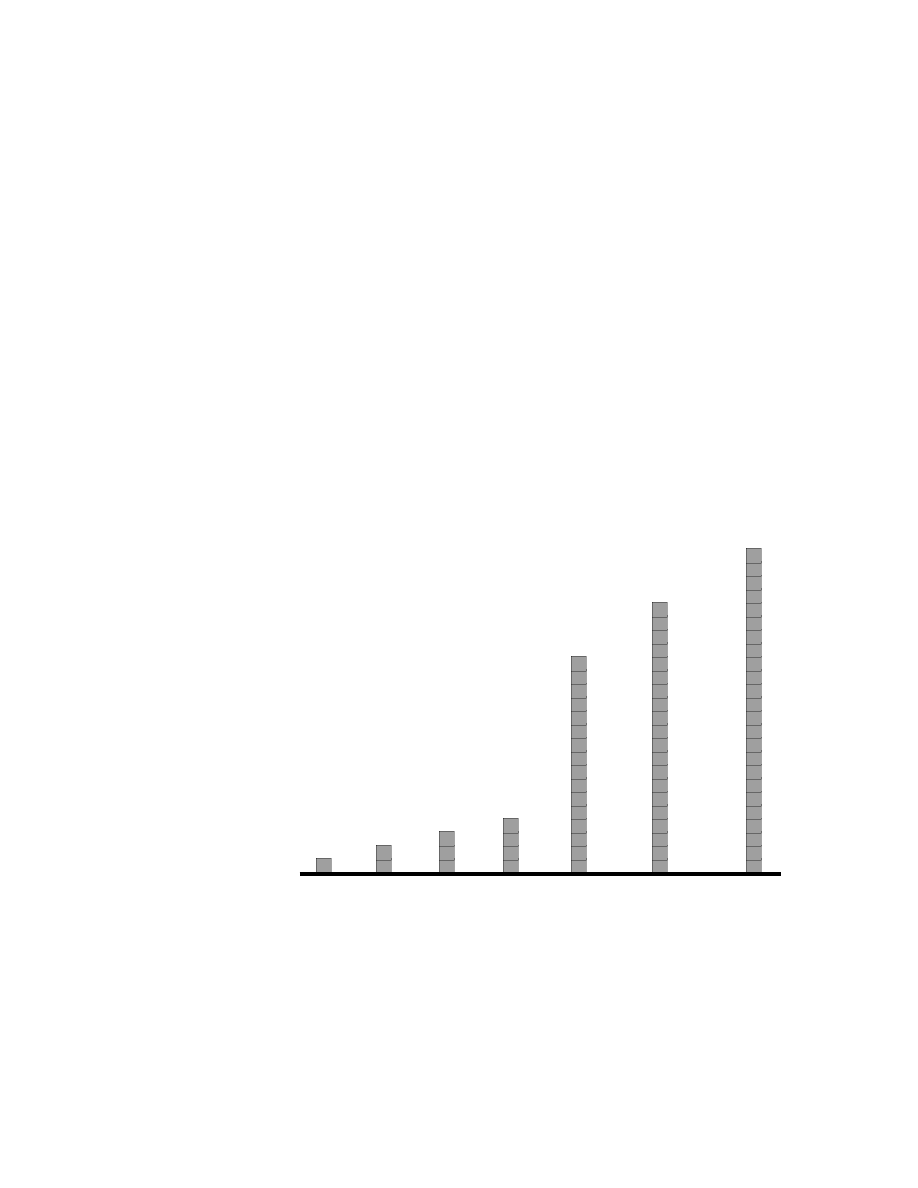ВУЗ: Казахская Национальная Академия Искусств им. Т. Жургенова
Категория: Учебное пособие
Дисциплина: Не указана
Добавлен: 03.02.2019
Просмотров: 12319
Скачиваний: 6

B
bandwidth: (1) The capacity of the channel through which information can pass. In audio,
the rated bandwidth of a device is the portion of the frequency spectrum it can handle without
significant degradation. In digital communications, the bandwidth is the amount of data
that can be transmitted in a given period of time. (2) The bandwidth of a bandpass filter is the
upper rolloff frequency minus the lower rolloff frequency, i.e., the frequency range in Hertz, or
band, passed by the filter.
bank: (1) A set of patches. (2) A related set of items, e.g., a filter bank: a set of filters that
work together to process a given signal.
Bank Select: A type of MIDI controller message which specifies which bank of (receiving) se-
quencer programs to use; a way to get around the 128 program limit specified by MIDI.
bantam: See TT connector.
bar: In written music, a grouping of pulses into a convenient unit which falls between two
barlines. A barline is the vertical line which crosses the stave at regular intervals. The bar
begins with the downbeat and ends immediately before the next downbeat, and will contain
a constant number of beats of the type determined by the time signature, e.g., a bar of
4
4
will
have four quarter-note beats.
Barkhausen effect: The tendency of the magnetic elements or domains on a magnetic me-
dium to influence one another and to become magnetized in one direction or another as a
group rather than individually. This means that a magnetic medium, such as recording
tape, has a graininess in its magnetic makeup which is what causes most background noise,
or tape hiss. Modulation noise, which is only present in conjunction with a recorded signal, is
also caused by the Barkhausen effect, and is sometimes called Barkhausen noise.
barney: See blimp.
base: In magnetic recording tape, the thin ribbon of polyester or other plastic material to
which the oxide and back coating are applied, measured in mils. For example, the base of
most professional recording tape is 1.42 mils thick.
basic channel: In a MIDI device, the channel on which the device receives fundamental
messages governing its operation, e.g., Reception Mode changes. In Mono Mode, the basic
channel is the lowest-numbered channel.
basic track: The group of instruments or vocalists recorded first during a multitrack session.
This group, perhaps including bass, drums, and standard rhythm section, will be played
back through headphones to other instrumentalists who later overdub solos, lead or back-
ground vocals, or narration, and other sweetening or sound effects. See also backing track, bed.
basket: The metal frame of a loudspeaker.
bass: The very low end of the audio spectrum, approximately 20Hz-200Hz or 300Hz.
Bass Intermodulation (BIM): Bass intermodulation is a type of distortion caused by the
modulation of audible frequencies by subsonic noise.

B
bass build-up: An increase in molecular pressure variation, not molecular velocity, which
occurs at low frequencies at room boundaries. The pressure nodes for all frequencies build
up in the corners of rooms, particularly at the intersections of the walls and floor or walls
and ceiling. These regions can roughly be thought of as resonant spaces, and energy can be
trapped quite effectively by placing frictional absorbers at the desired quarter wavelength out
into the room from the corner. See bass trap, boundary effect.
bass reflex enclosure: A type of loudspeaker enclosure with a hole, or port, in the surface on
which the speakers are mounted, usually the front. Since this allows some of the energy
from the rear of the speaker cones to project into the listening area, bass reflex systems have
relatively high efficiency. Sometimes called a ported enclosure or a vented enclosure.
bass tip-up: See proximity effect.
bass trap: A specially designed low-frequency sound absorber to reduce the effects of
standing waves in recording studios. It is a tuned absorber and may have a narrow or wide
range of frequencies over which it operates. It usually consists of resonant wood panels with
absorptive material behind them, or suitably shaped slots in a wall or ceiling. See bass build-
up, boundary effect.
B-chain: The film industry’s term for the sound reproduction system, including amplifiers,
crossovers and loudspeakers. See A-chain, chain.
B-Channel: See ISDN.
beat: A regularly occurring pulse that can be heard or implied. (1) When two periodic sig-
nals are less than 20Hz or so apart in frequency, and if they are mixed together, the ampli-
tude of the combined signals will fluctuate as they alternately reinforce and cancel each
other. These amplitude fluctuations cause loudness fluctuations and are called beats. See
also difference tone. (2) In music, the sensation of a basic pulse from which all rhythm in the
piece is derived. Beats are of three types: downbeat is a strongly accented pulse, such as the
first in the bar; offbeat is any pulse other than the downbeat; upbeat, also called the anacrusis,
is a special case of offbeat which immediately precedes the first beat of the bar, and hence
the bar line.
bed: Background music used underneath a narrator or foreground dialog. Primarily ap-
plied to commercial radio or television spots. Also called basic tracks.
bel: The logarithm in base 10 of the ratio of two different levels of power, acoustic or electric.
Since large changes in loudness correspond to fractional portions of a bel, the decibel,
1
10
of a
bel, is used as the measurement unit of level for sounds and audio signals. See Appendix A.
bell filter: A type of filter that allows the boost or attenuation of a specified set of
frequencies around a center frequency. Bell filters often allow user adjustment of the center
frequency, Q, and the amount of boost or cut. Bell filters are sometimes also known as
haystack filters.
bench: In film, the editing table which consists of rewinds handling reels of 35mm picture
and mag film, a sprocketed synchronizer that keeps the reels in sync, in addition to providing
a count, and a squawk box. See mut.

B
bend: To change pitch in a continuous sliding manner, usually using a pitch-bend wheel or
lever. An upward bend is created by pushing away from the front of the modulation con-
troller, and creates an increasing pitch, and vice-versa. See bend depth.
bend depth: The amount of pitch-shift possible if the pitch-bend modulation controller is
moved as far as possible. This is usually set to a whole step, but for special effects (such as
electric guitar), it could be set to an octave or more.
Betacam: A professional analog videotape format employing the
1
2
” Beta format, but at an
increased tape speed, which gives picture quality comparable with the 1” C format. Betacam
also allows separate recording of the red, green, and blue picture information via its RGB
mode for computer use. This capability gives much better control of edge-cuts in special ef-
fects. Often called Beta for short.
Betamax: A system used for
1
2
” color videotape recording, developed by Sony for con-
sumer systems. Generally acknowledged to give higher picture quality than VHS.
B-format: A 1” professional video format developed by Bosch. Although generally consid-
ered superior to the standard C-format, B-format equipment is used only in a few production
and post-production facilities. B-format video masters must be transferred to C-format for
broadcast.
BG: Background. The walla in a commercial or other video production, over which other
sound effects, music, and dialog are dubbed.
biamp: Short for biamplification. A two-way crossover network.
bias: (1) Bias is the voltage or current that establishes the intrinsic noise floor of an active de-
vice. (2) In an analog tape recorder, bias is an ultrasonic signal, usually between 100kHz-
200kHz, which is mixed with the audio signal and applied to the recording head, reducing
distortion by reducing the hysteresis inherent in the tape recording process. This process is
known as AC bias because the bias current is alternating. The ideal setting of analog bias in-
volves a compromise between the MOL of the tape, noise, and third-harmonic distortion. In
general, classical recordings use a bias setting with lower distortion and lower MOL; rock or
other recordings prefer a higher distortion in order to get the highest S/N ratio. Digital re-
corders do not require bias as the signal consists only of a bitstream of 0s and 1s, regardless
of the audio frequency being recorded. (3) See electret microphone.
biased noise: A tape loop of audio silence, processed by a recorder with some kind of noise-
reduction enabled, such as Dolby-SR (where it is called SR noise) or dbx. Used to check
equipment for ground loops or other problems in recordings and/or masters. Sometimes
called an alignment recording. See Dolby noise.
bi-directional microphone: A figure-eight microphone.
bin: (1) A barrel into which strips of film hang, suspended from a row of pins or small nails
above. Also called an editing bin. (2) In tape duplication, the container or housing that holds
a tape loop to be duplicated.

B
binaural: Literally, “having two ears.” Because humans have two ears spaced apart by the
width of the head, the human hearing mechanism can make use of amplitude, phase (arrival
time) and spectral (frequency response) cues to help determine the direction from which a
perceived sound is coming. See binaural synthesis.
binaural synthesis: A type of recording-playback system where two microphone inputs are
specially processed to simulate the frequency-dependent time delays that would occur be-
tween the ears on a human head. The binaural localization cues are preserved, and the lis-
tener is able to achieve localization of sounds as if s/he were actually at the site where the
recording was made, despite the fact that binaural recording has no ability to accurate image
the sound. Also called dummy head recording.
binder: A liquid or gelatinous medium in which oxide particles are suspended for applica-
tion to magnetic recording tape. Usually consists of a solvent that evaporates, and an adhesive
substance which, when dry, permanently bonds the oxide to the base.
binding post: A type of terminal which allows wires, such as loudspeaker wires, to be con-
nected to the output of an amplifier with alligator clips, banana plugs or bare wire.
binky: Film sound slang for a mixing “top sheet,” indicating the layout and content of the
premixes. The layout is usually one column per premix.
bin-loop master: A special tape that is used in cassette duplication equipment. It contains
both sides of the tape and is either run at a very high speed or, for higher quality dubs, in
real-time.
B inputs: (1) An additional set of inputs to a mixer channel that allow either additional (but
not simultaneous) tracks to be assigned a mixer; (2) More commonly these days, a different
source of the same information that is appearing on the A inputs. This latter technique
allows a sound editor to work offline on a sequence while the mixer is adjusting the overall
EQ and level in automation, while playing back from another copy. The material is recorded
to tape, after witching inputs, when the editor is finished.
BIOS: Basic Input-Output System. An operating system which resides on ROM and is used
to control disk access, exclusively. Used in some samplers and sequencers to control the in-
ternal hard drive.
bi-phase: An electronic reference signal used by mag recorders, editing stations, and film
projectors. See bi-phase modulation, pilot tone, neo-pilot, and control track.
bi-phase modulation: In SMPTE timecode generation, the electronic process that produces
the signal containing the SMPTE data itself. A 1.2kHz square wave is momentarily modu-
lated to 2.4kHz with each new bit of location information coming from the master clock.
bi-phase/tach: An electronic pulse used by some film equipment and other motor-driven
devices. Similar to a bi-phase signal, but different in the way directional information is pro-
vided. See also tach pulse.

B
bipolar: A type of loudspeaker design where the sound emanates from the sides of the
monitor, specifically designed to be surround-sound monitors. These type of speakers work
well for ambience material, but less well for dialog, soundtrack or main effect sound. This is
opposed to a direct radiator speaker which distributes the sound in front, or a tripole design
which is a combination of a direct radiator and a bipole.
birdies: Extraneous high-pitched whistles sometimes present in tape-recorded signals
where the high-frequency content of the signal causes beats with the bias signal. Also used to
refer to high-pitched interference in AM radio reception.
bit: Binary digIT. The representation of data using base-2 arithmetic, i.e., a series of ones
and zeroes. Digital audio is encoded in words that are usually 8, 12, 16, 20 or 24 bits long (the
bit depth). Each added bit represents a theoretical improvement of about 6dB in the S/N ratio.
BITC: Burnt-In Timecode. Video that shows the SMPTE time on-screen in a window along
with the picture, eliminating the need to watch a time-code reader. Accurate in still-frame.
Sometimes called a window dub.
bit depth: The number of data bits used to encode each sample point. Bit depth determines
the accuracy of a sampler, converter, or other digital device in capturing momentary
changes in a sound’s amplitude. Typical bit depth is 16 bits, which is good for capturing
loud sounds, but less good for sounds in a quieter range. Also called bit resolution.
Dynamic Range as a Function of Resolution (Bit-Depth)
Number of Bits
Amplitude Steps
Dynamic Range
1
6dB
2
2
12dB
4
3
18dB
8
4
24dB
16
16
96dB
65,536
20
120dB
1,048,576
24
144dB
16,777,216
bite: A subjective term for the sharp onset or attack of a musical instrument, especially brass
instruments. Excessive bite can result from positioning microphones too close to the instru-
ment or from distortion caused by a momentary overload. See attack transient.